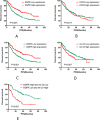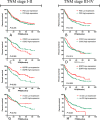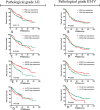Hierarchical investigating the predictive value of p53, COX2, EGFR, nm23 in the post-operative patients with colorectal carcinoma
- PMID: 27888614
- PMCID: PMC5352209
- DOI: 10.18632/oncotarget.13512
Hierarchical investigating the predictive value of p53, COX2, EGFR, nm23 in the post-operative patients with colorectal carcinoma
Abstract
The aim of this study was to evaluate the correlations between p53, COX2, EGFR, nm23 expression and the progression free survival (PFS) of post-operative patients with colorectal carcinoma. Immunohistochemistry was used to detect the expression of p53, COX2, EGFR and nm23 in 459 specimens from colorectal carcinoma patients. Kaplan-Meier estimates, Cox proportional hazard regression analyses and hierarchical analyses were performed on the collected data. Kaplan-Meier estimates analysis suggested that EGFR expression was as a negative predictor, the median PFS of patients with EGFR high expression was 21.73 months, and the median PFS of patients with low EGFR expression was 57.83 months (χ2=20.880, P<0.001); nm23 expression was positive predictive factor for the prognosis of patients with colorectal carcinoma, the median PFS of patients with high nm23 expression was 37.77 months, and the median PFS was 21.47 months in the patients with low nm23 expression (χ2=7.364, P=0.007). Cox regression analysis revealed that comparing with the patients with low expression of EGFR, the patients with high EGFR expression were at higher risk of tumor progression (HR=1.667, P=0.004); Comparing with the patients with high nm23 expression, the patients with nm23 low expression had a higher risk of tumor progression (HR=0.412, P<0.001); and the risk of tumor progression was higher in the patients with high EGFR expression and low nm23 expression (HR=0.245, P<0.001). Hierarchical analysis showed that EGFR expression mainly correlates with the PFS of TNM stage I-II colorectal cancer patients, the median PFS was 33.53 months in the TNM stage I-II colorectal cancer patients with high EGFR expression patients; The median PFS of the TNM stage I-II colorectal cancer patients with low EGFR expression was 70.43 months (χ2=9.530, P=0.002); The median PFS was 19.2 months in the TNM stage III-IV colorectal cancer patients with high expression EGFR, the PFS of the TNM stage III-IV colorectal cancer patients with low EGFR expression was 37.87 months (χ2=7.97, P=0.005). nm23 expression mainly correlates with the PFS of TNM stage III-IV colorecatal cancer patients. The median PFS was 47.27 months in TNM stage I-II colorectal cancer patients with nm23 high expression, the median PFS was 48.85 months in TNM stage I-II colorectal cancer patients with low nm23 expression (χ2=0.101, P=0.750); The median PFS was 28.8 months in TNM stage III-IV colorectal cancer patients with nm23 high expression, the median PFS was 14.7 months in TNM stage III-IV colorectal cancer patients with low nm23 expression (χ2=13.213, P<0.001). EGFR is mainly a predictive factor for the prognosis of post-operative patients with TNM stage I-II colorectal cancer, and nm23 is important for predicting the prognosis of patients with stage III-IV, and EGFR and nm23 could be as predictor of combination.
Keywords: EGFR; colorectal carcinoma; nm23; post-operative.
Conflict of interest statement
All authors have no potential conflicts of interest to disclose.
Figures




Similar articles
-
c-erbB-2, p53, and nm23 proteins as prognostic factors in patients with epithelial ovarian carcinoma.Croat Med J. 2003 Aug;44(4):429-34. Croat Med J. 2003. PMID: 12950146
-
[Expression and clinical significance of vascular endothelial growth factor-C and nm23-H1 in stage II and III colorectal carcinomas].Zhonghua Zhong Liu Za Zhi. 2013 Jun;35(6):439-44. Zhonghua Zhong Liu Za Zhi. 2013. PMID: 24119904 Chinese.
-
Clinicopathological significance and prognostic value of EphA3 and CD133 expression in colorectal carcinoma.J Clin Pathol. 2011 Jun;64(6):498-503. doi: 10.1136/jcp.2010.087213. Epub 2011 Mar 17. J Clin Pathol. 2011. PMID: 21415057
-
Prognostic value and clinicopathologic significance of nm23 in various cancers: A systematic review and meta-analysis.Int J Surg. 2018 Dec;60:257-265. doi: 10.1016/j.ijsu.2018.10.035. Epub 2018 Oct 31. Int J Surg. 2018. PMID: 30389538
-
Clinicopathological and prognostic significance of NM23 expression in patients with non-small cell lung cancer: A systematic review and meta-analysis.Medicine (Baltimore). 2021 Nov 24;100(47):e27919. doi: 10.1097/MD.0000000000027919. Medicine (Baltimore). 2021. PMID: 34964763 Free PMC article.
Cited by
-
Correlation between chemotherapy resistance in osteosarcoma patients and PAK5 and Ezrin gene expression.Oncol Lett. 2018 Jan;15(1):879-884. doi: 10.3892/ol.2017.7355. Epub 2017 Nov 6. Oncol Lett. 2018. PMID: 29391894 Free PMC article.
-
c-Myb and its Effector COX-2 as an Indicator Associated with Prognosis and Therapeutic Outcome in Colorectal Cancer.J Cancer. 2019 Feb 28;10(7):1601-1610. doi: 10.7150/jca.27261. eCollection 2019. J Cancer. 2019. PMID: 31205515 Free PMC article.
-
Investigation of hypoxia networks in ovarian cancer via bioinformatics analysis.J Ovarian Res. 2018 Feb 26;11(1):16. doi: 10.1186/s13048-018-0388-x. J Ovarian Res. 2018. PMID: 29482638 Free PMC article.
-
Comparison of overall survival and quality of life between patients undergoing anal reconstruction and patients undergoing traditional lower abdominal stoma after radical resection.Clin Transl Oncol. 2019 Oct;21(10):1390-1397. doi: 10.1007/s12094-019-02106-x. Epub 2019 Apr 20. Clin Transl Oncol. 2019. PMID: 31006088
-
Upregulated UCA1 contributes to oxaliplatin resistance of hepatocellular carcinoma through inhibition of miR-138-5p and activation of AKT/mTOR signaling pathway.Pharmacol Res Perspect. 2021 Feb;9(1):e00720. doi: 10.1002/prp2.720. Pharmacol Res Perspect. 2021. PMID: 33565716 Free PMC article.
References
-
- Costabile V, Duraturo F, Delrio P, Rega D, Pace U, Liccardo R, Rossi GB, Genesio R, Nitsch L, Izzo P, De Rosa M. Lithium chloride induces mesenchymaltoepithelial reverting transition in primary colon cancer cell cultures. Int J Oncol. 2015;46:1913–23. doi: 10.3892/ijo.2015.2911. - DOI - PMC - PubMed
-
- Liu X, George GC, Tsimberidou AM, Naing A, Wheler JJ, Kopetz S, Fu S, Piha-Paul SA, Eng C, Falchook GS, Janku F, Garrett C, Karp D, et al. Retreatment with anti-EGFR based therapies in metastatic colorectal cancer: impact of intervening time interval and prior anti-EGFR response. BMC Cancer. 2015;15:713. doi: 10.1186/s12885-015-1701-3. - DOI - PMC - PubMed
-
- Abdullah M, Rani AA, Sudoyo AW, Makmun D, Handjari DR, Hernowo BS. Expression of NF-kB and COX2 in colorectal cancer among native Indonesians: the role of inflammation in colorectal carcinogenesis. Acta Med Indones. 2013;45:187–92. - PubMed
MeSH terms
Substances
LinkOut - more resources
Full Text Sources
Other Literature Sources
Medical
Research Materials
Miscellaneous

